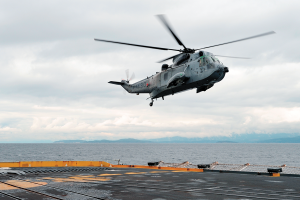Researchers develop system for safe Sea King landings
By Lookout on Jan 26, 2015 with Comments 1
Conducting helicopter operations from Royal Canadian Navy (RCN) ships is a complex and dangerous procedure requiring the highest degree of safety.
Defence Research and Development Canada (DRDC) has developed a specialized system that has the potential to increase the safety of complex at-sea operations, and ensure safer and smoother helicopter landings on RCN ships.
“Wind, speed, ship motion, and sea states all affect helicopter landings at sea,” says T. J. Caron, Ship Modification Lead Engineer, Project Management Office, Maritime Helicopter Project.
The DRDC Flight Deck Motion System measures and predicst ship and wave motions, and present a complete picture to the operator.
“It is a valuable tool in ensuring safer operation of maritime helicopters and RCN ships, and reducing the risk to Canadian Armed Forces members during takeoff and landing,” says Caron.
The RCN uses the estimates and wind measurements to determine ship course and speed for helicopter operations.
When a helicopter takes off or lands on deck, the sensor mounted under the flight deck relays information to the real-time module of the Flight Deck Motion System.
It measures and displays the current ship motions, and indicates whether the ship and helicopter are within safety limits for the takeoff or landing operation.
The Flight Deck Motion System was originally developed to assist with CH-148 Cyclone Ship Helicopter Operation Limits trials.
Most recently, the system played a role in the re-certification of Canada’s CH-124 Sea King helicopters for operations on the 12 newly refitted Halifax-class patrol frigates.
Part of the Frigate Life Extension program, the refit resulted in changes to the frigate superstructure, the part of the ship that is above the main deck.
Changes had the potential to impact the wind flow over the flight deck, alter the ships’ previously known air-wake, and increase the risks of flying in close proximity to the ship.
To ensure the superstructure modifications would not impact helicopter operations, the National Research Council tested the impact of the changes on wind flow under controlled conditions at their wind tunnel testing facilities.
In addition, the Royal Canadian Air Force tasked the Aerospace Engineering Test Establishment with redefining Sea King ship-helicopter operating limits.
During Sea King flight tests, Aerospace Engineering Test Establishment partnered with DRDC and the National Research Council to conduct a sea trial, in uncontrolled conditions, using the Flight Deck Motion System in HMCS Fredericton.
During the trial, the system fully illustrated the effect of the complex sea conditions on ship motion, displayed the constantly shifting flight deck motions relative to pre-defined limits, and enabled the identification of safe recovery course and speed in the event of an in-flight emergency.
DRDC will continue to work with the Maritime Helicopter Project Management Office to support the potential commercialization of the Flight Deck Motion System, and help ensure that it is available to install on RCN ships in the future.
DND
Filed Under: Top Stories
About the Author:







[…] their specific expertise and extensive experience in underwater acoustics and geobuoy technology, DRDC are uniquely positioned to conduct the evaluation of the redesigned geobuoy, Maj Gullison […]